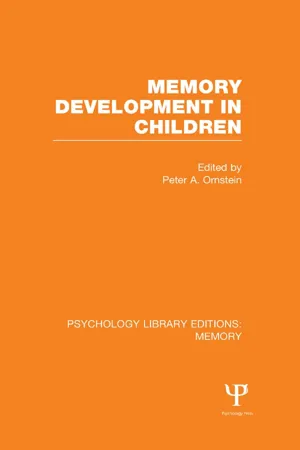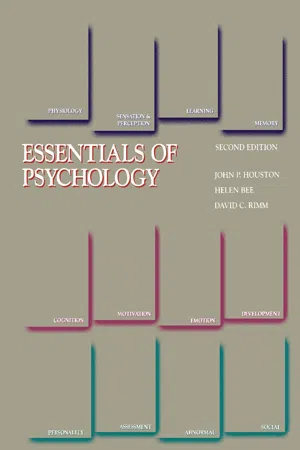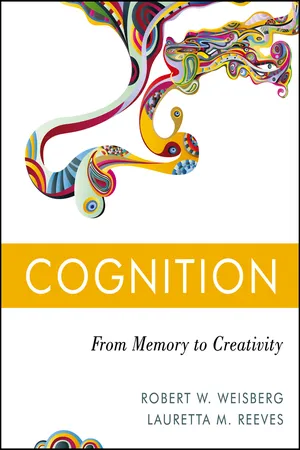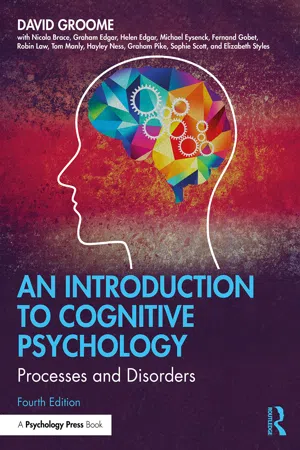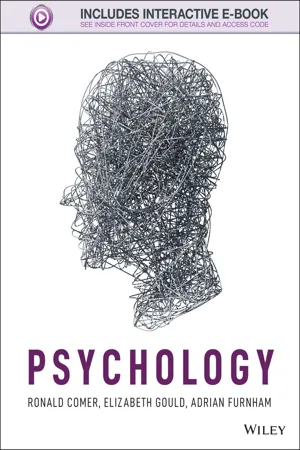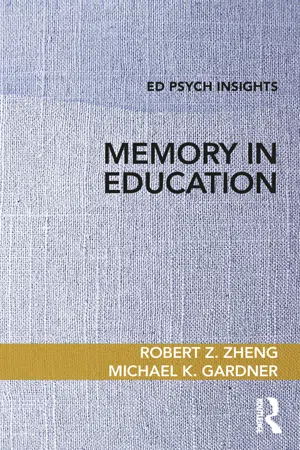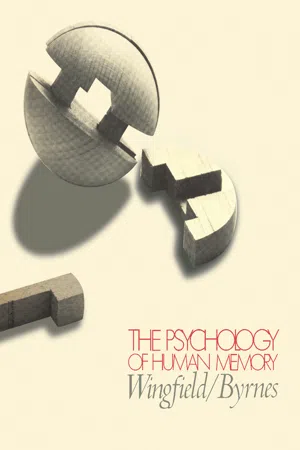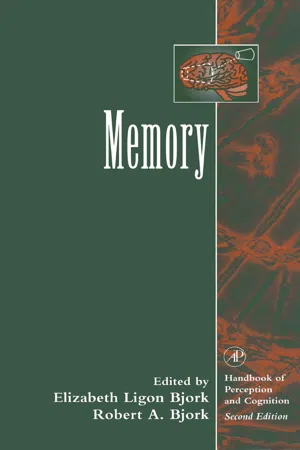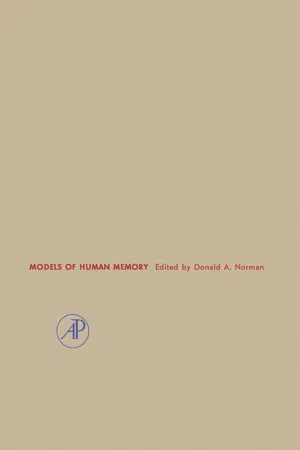Psychology
Multi-Store Model of Memory
The Multi-Store Model of Memory, proposed by Atkinson and Shiffrin in 1968, suggests that memory is composed of three main storage systems: sensory memory, short-term memory, and long-term memory. Information is initially processed in sensory memory, then transferred to short-term memory for temporary storage, and finally, some information may be encoded into long-term memory for more permanent retention.
Written by Perlego with AI-assistance
Related key terms
1 of 5
10 Key excerpts on "Multi-Store Model of Memory"
- eBook - ePub
- Peter Ornstein(Author)
- 2014(Publication Date)
- Psychology Press(Publisher)
The adult memory literature currently provides two alternative conceptualizations of the memory system: the multistore (e.g., Atkinson & Shiffrin, 1968, 1971) and the levels of processing (e.g., Craik, 1973; Craik & Lockhart, 1972) frameworks. Both of these conceptualizations represent broad overviews of the human memory system that can serve to organize the research literature. Further, although these frameworks differ in orientation and in the assumptions which are made about the memory system, they are similar in many respects. From a developmental perspective, one obvious “similarity” is that neither class of models is particularly developmental in orientation. In both frameworks, the memory system is viewed as static and unchanging, rather than as the evolving, growing system which a developmental point of view requires (see Naus & Halasz, 1978). It is the aim of the present paper to compare and contrast these two broad approaches to memory in order to determine the extent to which each provides a useful context for a thorough understanding of memory development in children. A brief description of the memory system from each of these points of view is initially provided. The contributions of each system for integrating, specifying, and understanding memory development are then explored.A MULTISTORE VIEW
A multistore view of the memory system was first suggested almost 100 years ago when William James (1890) differentiated between primary and secondary memory. According to James, information currently in consciousness was thought to reside in “primary memory,” whereas information not in consciousness was represented in “secondary memory.” Despite this early interest in a multistore position, however, this view did not become popular until relatively recently when, following the critical work of Broadbent (1958), Brown (1958), and Peterson and Peterson (1959), the notion of “short-term” memory began to be actively explored. During the 1960s much data was interpreted as providing support for a distinction between short- and long-term memory (e.g., Baddeley, 1966; Conrad, 1964; Craik, 1968, 1970; Glanzer & Cunitz, 1966; Wickelgren, 1965, 1969), and several formal models of the memory system were proposed. Although these models differ in terms of the number of proposed stores and the interrelationships among them (e.g., Atkinson & Shiffrin, 1968, 1971; Feigenbaum, 1970; Hunt, 1971; Shallice & Warrington, 1970; Waugh & Norman, 1965), the “modal” model (see Murdock, 1967) incorporates three distinct types of memory storage: sensory registers, short-term store, and long-term or permanent store. Information is thought to flow through these component stores in a well-regulated fashion, progressing from the sensory registers (one for each modality) to the short-term store and finally into the long-term store.A specification of the characteristics which define and differentiate the memory stores was central to the initial generation of these multistore models. Thus, for example, Atkinson and Shiffrin argued that: (1) short-term store was limited in its capacity, whereas long-term store was essentially unlimited; (2) information was held in short-term store in an auditory-verbal-linguistic code, whereas storage was primarily semantic in long-term store; and (3) information loss from short-term store might be due to decay and/or displacement, whereas interference factors and temporary irretrievability were seen as two of the critical determinants of forgetting from long-term store. In addition, however, multistore theorists quickly found it necessary to attempt to specify the processes by which information is assumed to flow through the memory system. Waugh and Norman (1965), for example, indicated that rehearsal represented one such process. Atkinson and Shiffrin (1968) further extended this notion by formally differentiating between the structural features of the memory system and the attendant control processes. Structural features, much like the “hardware” in a computer system, were considered to be the various memory stores and the built-in processes which are fixed and invariant across a variety of memory tasks. In contrast, control processes were defined as those storage and retrieval operations which are under a subject’s control and which can vary with the task demands. Extending the computer analogy, these control processes were taken to be similar to computer “software,” the programs which could be written by a “programmer” to operate the system according to the demands of specific situations. - eBook - PDF
- John P. Houston, Helen Bee, David C. Rimm(Authors)
- 2013(Publication Date)
- Academic Press(Publisher)
This new approach con-ceives of the human being as an information*processing system. Accord-ing to this way of thinking, memory involves the flow of information through the organism, beginning with encoding and storage and ending with the retrieval of stored information. The number of specific models of memory that have developed within this new tradition is quite astounding (see Atkinson & Shiffrin, 1971; Broadbent, 1971; Craik & Lockhart, 1972; Hilgard & Bower, 1975; Lind-say & Norman, 1977; Ratcliff, 1978; Wickelgren, 1979). We will con-sider a model of memory that represents a distillation of several different models, because many of the available models agree with one another in important ways. These areas of agreement are summarized by the flow diagram in Figure 5. Notice that the model in Figure 5 contains three distinct types of memory—sensory memory, short-term memory, and long-term memory. Most recent information-processing models define three types of memory, while the older interference theory specifies only one memory process. In Figure 5 information is presumed to move through these three memory systems from left to right. Perceived information first FIGURE 5 The three human memory systems. Stimulus Sensory memory Rehearsal Short-term memory Long-term memory Retrieval o / 7 V 174 Chapter 5 Memory enters sensory memory; it may then be transferred to short-term memory, and finally to long-term memory. In essence, the argument for having three memories, or stores, is that the ways in which we remember items for very short periods of time differ from the ways in which we remember the same items for long periods of time, For example, if you wanted to remember 193-2040 for a very short time (say, 30 seconds), you might do it by remembering the sounds of the numbers and by arranging these sounds into some easily remembered pattern or rhythm such as one-nine-three-twenty-forty. - eBook - PDF
- Nancy Ogden, Michael Boyes, Evelyn Field, Ronald Comer, Elizabeth Gould(Authors)
- 2021(Publication Date)
- Wiley(Publisher)
Together these three stages of memory explain how we process information into and out of memory. The three systems of memory proposed by the information-processing model are com- parable to the operation of a computer. The small icons on our desktop are essentially small images that represent much more complex programs. Sensory memory works in a similar way, giving us a quick copy of the information in our environment. In addition, information saved to working memory is roughly equivalent to the information that a computer retains for as long as a document or website is open, but which disappears if you do not save it. And the final memory system, long-term memory, is the equivalent of the computer hard drive, storing information until something causes disruption or loss of the memory. These three systems are sometimes referred to as memory stores. The information-processing model has generated a great deal of research that we will explore further in the sections of this chapter that focus on encoding, storage, retrieval, and forgetting. Consider for a moment what happens when you study. In order to eliminate competing stimuli (you set your phone to vibrate, close social media, and tell friends you need some quiet time), you sit in an area free of distraction and focus on your work. This behaviour allows sensory memory to elimi- nate non-specific stimuli so that working memory can process the information for the task at hand. As you process material, the information is gradually moved to long-term storage. We will discuss ways this can be done most effectively throughout the chapter. Although the information-processing model suggests that sensory memory, working memory, and long-term memory correspond roughly to computer memory structures, we need to be clear that this is just a metaphor. If you break open a computer, you can find the dedicated modules where the various forms of memory are in operation. - eBook - ePub
Cognition
From Memory to Creativity
- Robert W. Weisberg, Lauretta M. Reeves(Authors)
- 2013(Publication Date)
- Wiley(Publisher)
As noted in Chapter 1, James (1890) made a distinction between primary (short-term) and secondary (long-term) memory, and it certainly seems to many of us that there is a difference between recalling information that is stored only on a short-term basis versus recalling information that has been stored longer. By way of demonstration: Read the following words aloud, then turn away from the book and repeat them in the same order. Here are the words:CLOUD, HAND, PENCILPresumably, this posed no challenge, since you had just read the words. Now, what was the name of your fifth-grade teacher, or the name of the kid who was the class troublemaker in fifth grade? Answering those questions requires retrieving information that was acquired long ago. Perhaps your fifth-grade teacher's name came to mind easily, but remembering the name of your classmate required more effort—you thought about fifth grade, then recalled some incident from that year, and then ran through a mental list of other classmates before you recalled the desired name. Unlike the case of recalling words that one has just read, retrieving some information from deep in the past has a very different feeling: One has to work at the remembering, and perhaps use retrieval cues to access the information fully.Those different types of memory experiences led James (1890) to consider the possibility that there are more ways than one to store information in memory. That belief formed the basis for the Multi-Store Model of Memory, proposed by Atkinson and Shiffrin (1968, 1971). This theory proposes that there are three separate memory structures or stores (hence the name)—sensory store, short-term store (STS), and long-term store (LTS). Those memory structures are assumed to be permanent and unchangeable, like the hardware of a computer, and each has distinct properties concerning its capacity (how much information it can hold), duration (how long information is held in the store before being passed on), and code (the form of the information held in the store). The Atkinson and Shiffrin model, depicted in Figure 2.2 , is also a prototypical information processing theory: The process of memory is decomposed into component stores and subprocesses; information comes into the system and is changed in code as it passes through the system. In addition to the structural features, the system also consists of control processes - eBook - ePub
An Introduction to Cognitive Psychology
Processes and Disorders
- David Groome(Author)
- 2021(Publication Date)
- Routledge(Publisher)
chapter 5Short-term memory
David Groome and Robin LawDOI: 10.4324/9781351020862-5ContentsSummary 5.1 Multistore models of memory 5.2 Measuring STM performance 5.3 The working memory model 5.4 Later revisions of the working memory model 5.5 The central executive 5.6 Other working memory theories 5.7 Neuro-imaging studies and working memory Summary Further reading5.1 Multistore models of memory
The dual-store theory of memory
Information which has been perceived will sometimes be put into the memory store. Early cognitive psychologists assumed that there was just one memory store, but William James (1890) suggested that there were two separate stores, one for items being held briefly in conscious awareness and the other for items held for longer periods in unconscious storage. He called these two stores ‘primary memory’ and ‘secondary memory’ respectively, though they subsequently became known as short-term memory (STM) and long-term memory (LTM) . James made the distinction between the STM and LTM stores essentially on the basis of subjective experience. He felt that conscious memories seemed different to the memories in storage, and seemed to have different characteristics. James was a psychologist of great intuitive genius, and like many of his theories the distinction between STM and LTM remains plausible to this day.Short-term memory (STM) Memory held in conscious awareness, and which is currently receiving attention (contrasts with long-term memory).Long-term memory (LTM) Memory held in permanent storage, available for retrieval at some time in the future (contrasts with short-term memory).STM refers to the memories which are currently receiving our conscious attention, and it is a temporary store of very brief duration and limited capacity. LTM refers to the memories which are not presently in conscious awareness, but which are held in storage ready to be recalled. The LTM store has a very large capacity and can hold information for a lifetime. Atkinson and Shiffrin (1968) used these ideas to develop a theoretical model of memory, which is shown in Figure 5.1 - eBook - PDF
- Ronald Comer, Elizabeth Gould, Adrian Furnham(Authors)
- 2014(Publication Date)
- Wiley(Publisher)
And the final memory system, long-term memory, is the equivalent of the computer hard drive, storing information until some- thing causes the disruption or loss of the memory. These three systems are sometimes referred to as memory stores. The information-processing model has produced a great deal of research, which we will explore further in the sections of this chapter that focus on encoding, storage, retrieval and forgetting. Although the information-processing model suggests that sensory memory, working memory and long-term memory correspond roughly to computer memory struc- tures, we need to be clear that this is but a metaphor (Silva, 2011). If a computer were to be opened up, the various forms of memory would be easily seen. This is not the case with the human brain, however, as equivalent specific structures where short-term memory and long-term memory exist have not yet been identified. Unlike the information-processing model, which sug- gests that information is stored and retrieved piece by piece, an alternative model of memory, the parallel distributed- processing (PDP) (or connectionist) model holds that newly encountered pieces of information immediately join with other, previously encountered, pieces of information to help form and grow networks of information (McClel- land, 2011). Such networks result in sophisticated memories, broad knowl- edge and the ability to make better deci- sions and plans in life by generalizing. - eBook - ePub
- Robert Z. Zheng, Michael K. Gardner(Authors)
- 2019(Publication Date)
- Routledge(Publisher)
TwoInformation Processing Model of Human Memory
During the 1960s, cognitive psychologists began to explore how people process information. They were heavily influenced by the advent of computers and tried to identify similarities between human information processing and computer information processing. The process went something like this: (a) environmental stimuli exist in the external world and are detected by sensory organs such as the eyes, ears, nose, and skin surface; (b) this sensory information is held briefly in a sensory memory so that it can be identified as meaningful objects, and so on; (c) the identified information is stored in a time-limited, short-term memory—here the information can be transformed and processed; (d) the information can then be transferred to a relatively permanent long-term memory, where it can be stored until needed in the future; and (e) the information in long-term memory, combined with information in short-term memory, can give rise to responses, which is the way the individual effects his or her environment.By 1968, this had been summarized by Richard Atkinson and Richard Shiffrin into what has been termed “the modal model of memory” (see Figure 2.1 ).2 ,3As can be seen in the figure, human memory had been divided into three qualitatively different types of memory. It is perhaps best to discuss each of these memory stores in greater detail.Figure 2.1 The Modal Model of MemorySensory Memory
When external information enters the information processing system, it is held by a sensory memory. There is likely a sensory memory for each of the senses, but the two most extensively studied sensory stores are those for visual and auditory information. These are sometimes referred to as iconic memory (for the visual system) and echoic memory (for the auditory system). The existence of a sensory memory was demonstrated in a number of experiments performed by George Sperling.4 - eBook - PDF
- Arthur Wingfield, Dennis L. Byrnes(Authors)
- 2013(Publication Date)
- Academic Press(Publisher)
Of some, no memory survives the instant of their passage. Of others, it is confined to a few moments, hours, or days. Others, again, leave vestiges which are indestructible, and by means of which they may be recalled as long as life endures. Can we explain these differences? (p. 643) 240 Chapter Seven Short-;ertn, Memory Short-Term Memory as a Structural Store Process Views of Memory James' question was how to conceptualize this distinction and how to derive a useful framework for its systematic investigation. By the end of the 1940s, John Watson's behaviorism had clearly estab-lished its influence in American psychology, and with it, the concept of consciousness had all but disappeared from the research vocabulary. To be sure, memory research in the 1950s wished to understand those mental events which occurred between a stimulus and a response. Thus, Watson's behaviorism no longer dominated the exploration of memory. Nevertheless, one vestige of his arguments remained; the concept of consciousness was not to be found in the models and theories of this period. Rather, as we saw in Chapter 5 memory function was divided into a series of discrete, structural memory stores, each with its own characteristics and role to play in the processing of memory information. Figure 5-1 showed the role of short-term memory in this system as a structural entity for temporarily holding recent information selected from sensory memory and prior to its transfer to long-term memory. This structural theory thus claimed two different kinds of memory, or infor-mation stores beyond sensory memory: short-term memory (STM) and long-term memory (LTM). At any one time, what we remember may be in STM or LTM, or perhaps sometimes, in both. This structural view of information processing led psychologists to ask questions about the capacity of these stores, how their content was coded, and how information was either lost from each store or trans-ferred from one store to another. - eBook - PDF
- Elizabeth Ligon Bjork, Robert A. Bjork(Authors)
- 1996(Publication Date)
- Academic Press(Publisher)
The magnitude of the sensory event serves as the structure for several different processes: information extraction and phenomenal appear- ance. B. Stage Models and Multiple Representations To justify the initial sensory storage as distinct from following processing stages and other perceptual representations, it is necessary to clarify the information processing framework. We have evidence that information can be maintained in memory at multiple levels and in various forms. This parallel storage of information does not negate the sequential stage model, however. What is important to remember is that transfer of information from one stage to another does not require that the information is lost from 96 Dominic W. Massaro and Geoffrey R. Loftus the earlier stage. Reading a word does not obliterate its visual representa- tion. For our purposes, we now understand that the representation of an earlier processing stage maintains its integrity even after it has been trans- formed and transmitted to the following processing stage. Thus, it is entirely reasonable to have multiple perceptual and abstract representations within stage models of information processing (e.g., Baddeley, 1986; Mas- saro, 1975a). Acknowledgments The research reported in this chapter and the writing of the chapter were supported, in part, by grants from the Public Health Service (PHS R01 NS 20314 to DWM and NIMH MH413637 to GRL), the National Science Foundation (BNS 8812728 to DWM), and the graduate division of the University of California, Santa Cruz to DWM. GRL would like to acknowledge Tom Busey and Eric Ruthruff as collaborators on the linear-filter theory. The authors thank Nelson Cowan and Mary Sue Weldon for their comments. References Averbach, E., & Coriell, H. S. (1961). Short-term memory in vision. Bell Systems Technical Journal, 40, 309-328. Averbach, E., & Sperling, G. (1961). Short-term storage in vision. In C. Cherry (Ed.), Sympo- sium on Information Theory (pp. 196-211). - eBook - PDF
- Donald A. Norman(Author)
- 2013(Publication Date)
- Academic Press(Publisher)
There are also many different sublevels within each of these three major categories of levels. By a theoretical level, I mean the degree of detail with which the memory process is described. One is attempting to describe the memory process in more detail at a molecular level than at a neuronal level than at a psychological (functional, behavioral) level. Ultimately, we want adequate theories of memory at molecular, neuronal, and psychological levels. It may turn out to be possible to derive the psychological theory from the neuronal theory and the neu-ronal theory from the molecular theory. Alternatively, one or both of these derivations may be too complicated to be worth the effort. This is not our concern at present. The concern of the present paper is to develop a possibly adequate theory of memory at a psychological level. The theory, called multi-trace strength theory, is rather detailed in that it analyzes the memory trace into components and phases, but both the componential and phase analyses are less detailed (mechanistic) than some might desire. How-ever, multitrace strength theory will attempt to achieve complete generality with respect to the basic functional properties of memory. The basic properties of multitrace strength theory are as follows: each event and each association between two events is characterized by a vector of unidimensional strength measures for each of four pos-sible time traces (very-short-term memory, VSTM: short-term memory, STM; intermediate-term memory, ITM; and long-term memory, LTM) in each of an unknown number of modalities (visual, auditory, speech-motor, ab s tract-verbal, etc.). Each trace in each modality passes through four phases (acquisition, consolidation, decay, and retrieval). The acquisition phase refers to the period of presentation or active rehearsal of events during which the memory traces are initiated.
Index pages curate the most relevant extracts from our library of academic textbooks. They’ve been created using an in-house natural language model (NLM), each adding context and meaning to key research topics.
